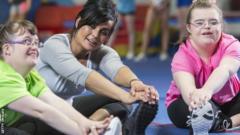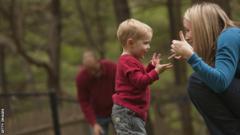What are the benefits?
For all children, the benefits of engaging in regular physical activity are well-established. Focus is often cast on physical benefits such as improved cardio-vascular fitness, reduced risk of becoming overweight or obese, and increased bone and muscle strength. These are especially important for children with Special Educational Needs and Disabilities (SEND) who, in general, experience poorer physical health outcomes than other children of the same age.
There is also evidence pointing towards a relationship between physical activity and improved mental well-being, the development of problem solving skills, and increased concentration and academic achievement among children with SEND. When children with SEND engage in physical activity in groups, especially when those groups include children without SEND, they have been found to develop important life skills like verbal and non-verbal communication, sharing and the ability to make and keep friends. These skills are crucial in later life for developing strong and supportive social networks, gaining employment and living independently.
Inclusion
‘Inclusive’ physical activities, whereby children with and without SEND participate with and against each other, are beneficial to all children. For instance, research suggests that there are significant social benefits for children without SEND, such as increased tolerance to individual differences, greater awareness and sensitivity to human diversity and the needs of others. Therefore, the onus should be on physical activity providers to deliver inclusive physical activities, whether that be in school, club or other settings.

Studies have shown that children with SEND participate less frequently and in a narrower range of physical activities than other children of the same age. While the reasons for this are complex and can differ from child-to-child, research suggests that some of the main issues relate to attitudes to ‘including’ children with SEND among teachers, coaches and other children; a lack of specialist knowledge, skills and confidence to teach and coach children with SEND; schools, leisure facilities and clubs being inappropriately resourced to provide physical activity opportunities to children with SEND; and a lack of accessible information about opportunities to engage in physical activity in local communities.
Good practice
Fortunately, there is a growing number of organisations that are doing excellent work to ensure that children with SEND have the opportunities to develop physical activity habits that last a lifetime. School, whether that be a special or mainstream setting, is an ideal context for children to engage in physical activity through formal, structured physical education lessons, and lunchtime and after school clubs. More recently, attempts have been made to encourage parents and children to abandon their cars and build physical activity into their travel to and from school plans.

Playground markings and ‘the daily mile’ are also being used by schools to encourage physical activity engagement during break time. Here, success will depend on the extent to which these opportunities are aligned to the specific needs and capabilities of the children. ‘One size fits all’ approaches are mostly ineffective ways of increasing physical activity participation levels among children with SEND. Therefore, it is vital that those delivering physical activity to children with SEND have the appropriate knowledge, skills, experience and confidence to do so.

The Youth Sport Trust (YST), which is a national children’s charity committed to ensuring that every child can enjoy the benefits associated with physical activity, is one of many organisations working in partnership with schools. Through its Lead Inclusion School Network, the YST provides training, advice and guidance to school leaders about the development of provision aimed at ensuring that children with SEND can engage and participate in regular physical activity. This is part of a broader attempt to upskill primary school teachers in particular, many of whom are not physical education nor SEND or inclusion experts. Given that childhood is crucial for establishing positive (or negative) habits, primary school teachers are one group who play an important role in shaping the physical activity participation tendencies of children with SEND.

The training of teachers and coaches is vital. Teachers and coaches should receive awareness training about the benefits of children with and without SEND participating in physical activities together. Moreover, through appropriate training teachers and coaches need to understand and be able to apply principles of inclusion through the modification and adaptation of physical activities to suit the needs and capabilities of all children. Here, a ‘capabilities’ approach is essential when working with children with SEND. For far too long we have focused on understanding what children with SEND cannot do, and how to meet their needs. While this is useful, so too is casting light on what these children are good at.
Child-centred approach

Like all children, it is important that those with SEND are stretched and challenged so that they can fulfil their sporting and physical activity potential. To achieve this, a child-centred approach is required. Children with SEND should be involved in decisions that shape their lives. After all, these children know and understand their needs and capabilities much more than an adult without SEND. Involving children in this way has been found to increase motivation, engagement, self-esteem, and feelings of self-worth among children with SEND.
Parents

Parental involvement is also crucial. Parents act as role models to children. Children with SEND, like all children, are more likely to be physically active outside of school if their parents are. After all, parents are often the ones that find opportunities for their children to be physically active, pay any associated costs, and act as taxi driver. Therefore, engaging in physical activity outside of school as a family is important. Going to the park for a walk, to woodlands or forests to play, or joining local clubs or leisure centres are a few ways in which families of children with SEND can engage in physical activity together.

The BBC has teamed up with the Premier League to create ‘Super Movers‘, which aims to inspire primary school children to become more physically active. If you are looking for opportunities for your child to join a local club, the Parasport and BBC’s Get Inspired ‘club finders’ are useful starting points. Boccia, goalball and wheelchair dance are just a few examples of activities with a particular emphasis on inclusion. Alternatively, the Activity Alliance deliver inclusive sporting events.
News article and image source:









